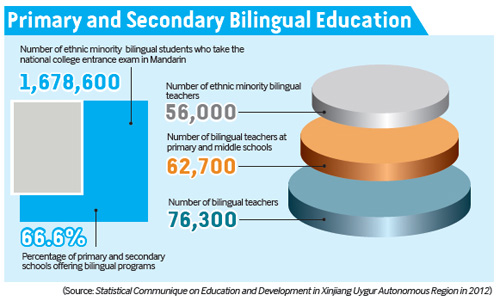|
Teacher training
Improving bilingual education faces a number of challenges. Ayizaguli, a Uygur teacher at Center School of Heshilik Township, Korla City, said, "If we teach solely in Mandarin, students cannot understand. If we teach just in our native Uygur language, students won't perform well on tests. This is the difficulty we face."
This dilemma restricts the expansion and development of bilingual education in Xinjiang. To develop bilingual education further, three main problems have to be addressed: the shortage of teachers; low professional skill; and the low Mandarin ability of teachers.
"A total of 165,500 bilingual teachers will be trained by 2020," said Dai Xiang, an official in charge of Xinjiang's bilingual education. "As we improve teacher training, we should overcome these three problems."
New training programs focusing on Mandarin proficiency and related teaching skills have been provided to bilingual teachers in Xinjiang since June.
In Shache, a training center for bilingual teachers opened earlier this year. With the best facilities in the area around Kashgar, it will provide training courses for more than 1,200 bilingual teachers in the county. According to Lu Yong, Deputy Director of the county's Education Bureau, the first group of 250 outstanding ethnic minority teachers had received training there.
In addition, Xinjiang has invested 53 million yuan ($8.66 million) in updating bilingual textbooks and other materials. Those books were provided to classrooms in September.
Making dreams come true
"My dream is to pass the national college entrance examination and study at Zhejiang University," said the 14-year-old Alim, a student at No.66 Middle School in Urumqi. "And then I will come back to Kashgar to be a policeman, protecting the people I love and the people who love me."
Founded in 1897, Zhejiang University ranked 28th on the 2013 Asian University Rankings released in June by the British higher education consulting company Quacquarelli Symonds, best known for their annual QS world university rankings. It is the sixth most prestigious amongst all the higher learning institutions on the Chinese mainland.
Alim's parents are both farmers. He said that if the government hadn't created special bilingual education programs to help ethnic minority students, kids like him would never have a chance to go out and see the rest of the world.
Alim is in charge of extracurricular activities for over 10 clubs at his school. Like other students at the school, he enjoys a free education and is given a living allowance by the government.
The advantages of a bilingual education are obvious in Xinjiang. Hailiqm Naimaiti, a college graduate and village official in Baja Village, Shayar County, opened up a bilingual training class for surplus rural laborers. Nine students in her class, who had never left the village because of language barriers before joining her class, found well-paid jobs outside Xinjiang.
"With the development of bilingual education in Xinjiang, more and more parents have realized that their children must have a good level of Mandarin in order to achieve a better future," Dai said. While expanding the reach of the local people, bilingual education also helps to narrow the gap between Xinjiang and other regions in China in terms of educational level. It has also helped more and more local students turn their dreams into reality.
Email us at: yaobin@bjreview.com
 | 